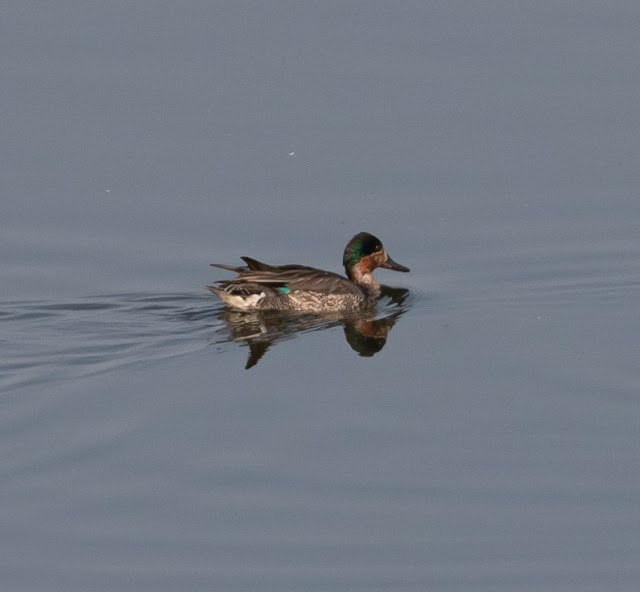I was hoping to find migrant snipe over the past week, both locally, here in Kyoto, and across in Mie. Unfortunately there's precious little good looking workable habitat and I didn't find a single snipe. I expect there'll be birds around, I'm simply not looking in the right places. Very disappointing. Even more so considering I had a Latham's on 30 March, my earliest sighting yet. There wasn't much happening on the wader front in general, though it's still early days of course, but April is peak time for snipe passage in this area and I'd hoped for more success.
It isn't true to say I didn't find any snipe but the only one I came across surprisingly turned out to be Common. First thing in the morning it was running around and jumping over tussocks amongst the rank grass and mulleins on the upper beach, between the seawall and the sand. Strange place (and behaviour) for a Common Snipe.
The next bird to catch my eye was a hybrid Eurasian Teal, this is my first teal hybrid. It was on a pool with a few Eurasian Teals and Falcated Ducks and it's the latter which my be the other species involved. Maybe. The bird was never close and these photos are the best I could get.
 |
| There can't be any doubt one parent is a teal, but what's the other. Very heavy flank markings, the green crown and shaggy nape put me in mind of Falcated. Uppertail coverts aren't bad either. Quite where the white vent and undertail coverts come from, I have no idea. |
Next up was the Pallas's Reed; right place, right time, total luck. I wonder whether it was wintering here, or had wintered in the region and was now slowly on the move. It would have to be a very early (and rare) spring migrant otherwise.
I was hoping to see a nice breeding plumage Buff-bellied Pipit, most were in patchy transitional plumage, at best, and none had been close enough to photograph anyway. There were one or two Pipits I was trying to creep up on when two reed buntings flew up from the the far side of the opposite embankment, one perched in a bush and this bird on a wavy reed stem. From the word go this bird looked worth a closer look and through the scope I though I could make out blue-grey lesser coverts, well worth a closer look. By the time I'd binned it, scoped it, got my camera on it, time was surely running out, it wasn't going to perch up forever. The autofocus wouldn't grab, damn, I focused on the vegetation near the base of the wavy reed stem, and got one shot off before it flew. Double damn. Both birds flew round the corner of a largish building building - the only building in about 1.5km - and didn't seem to appear from the other side. I walked to the corner and peered round. There was a broad, deep ditch overgrown with reeds and bushes running along the base of the seawall embankment, a narrow track for the local mini-tractors and growing barley on the other side. A reed bunting was perched in a bush about 100m further along. How had it got so far without me seeing it? Was it even the same bird? I never got to find out because it flew again long before I could get close enough, and dived into the barley never to be re-emerge.
When I returned to the van I checked the results on the back of the camera and to my surprise the image was less out of focus than expected. On top of that, I'd jammed a second shot of it in flight, it's not going to win any photographic competitions but the wing coverts are amazingly clear. This is only the third mainland Pallas's Reed I've ever found. What a score!
 |
No photographic awards, but the all important lesser coverts are just visible.
|
 |
| Astonishingly, the lesser coverts are actually the clearest, most in focus point on the bird. No wonder I didn't find any snipe, I used all my luck on this shot. |
By now it was almost lunch time and an afternoon of gulling beckoned further up the coast.




No comments:
Post a Comment